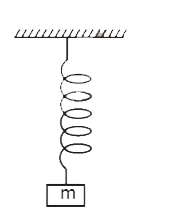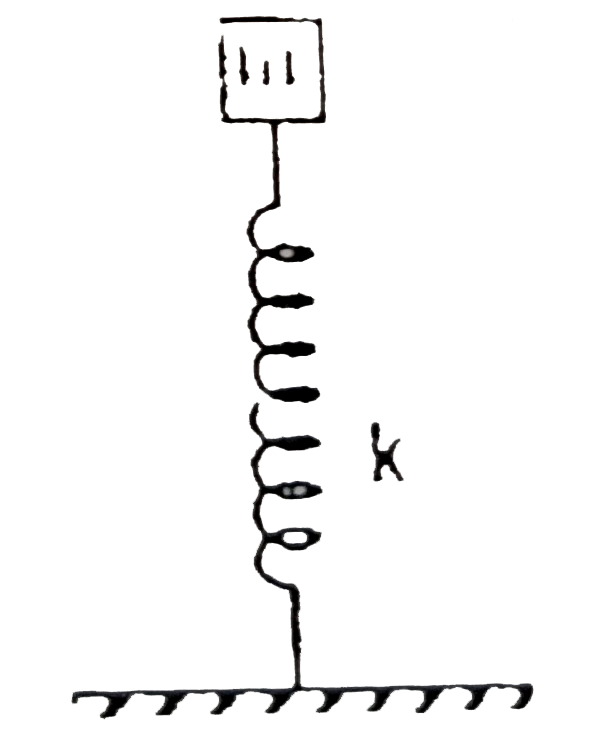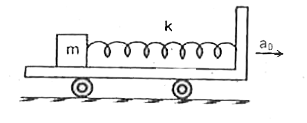A small block of mass m is attached to free end of a spring of force cosntant k , whose other end is fixed to a rigid support . The block is lying on a frictionless horizontal plane and it starts movi0ng away from fixed end of the spring a\t t= 0 with intial velocity u When the speed of the block is 0.6μ it collides with a fixed heavy mass elastically. After the collision with a fixed heavy mass elastically . Aftere the collision the time at which the block passes through its equilibrium position for the first time is close to
π√mK
1.86√mK
2√mK
2π√mK
The correct Answer is:C
The given situation is

The collision of bloc with the heavy mass is leastic, So, the block will rebound with same speed u to equilibrium after collision.
In S.H.M. x=Asinωt
v=Aωcosωt
cosωt=35
cosωt=35
ωt=0.93
t=0.93√mK
This is the time taken by th blcok to reach the heavy mass.
∴ Time of passing equilibrium position for the first time is
t1=2×0.93√mK
≈1.86√mK
Topper's Solved these Questions
- OSCILLATIONS Book:MODERN PUBLICATIONChapter:OSCILLATIONS Exercise:Competition File (Multiple choice questions) AIPMT/NEET other State Boards for Medical Entrance
Explore 14 Videos
- OSCILLATIONS Book:MODERN PUBLICATIONChapter:OSCILLATIONS Exercise:Competition file (Multiple choice question) JEE (Main) & Other State Boards for Engineering Entrance
Explore 25 Videos
- OSCILLATIONS Book:MODERN PUBLICATIONChapter:OSCILLATIONS Exercise:Revision Exercises (Numerical Problems)
Explore 23 Videos
- MOTION IN A STRAIGHT LINE Book:MODERN PUBLICATIONChapter:MOTION IN A STRAIGHT LINE Exercise:CHAPTER PRACTICE TEST
Explore 16 Videos
- PHYSICAL WORLD Book:MODERN PUBLICATIONChapter:PHYSICAL WORLD Exercise:Revision exercises (Long answer questions)
Explore 6 Videos
Similar Questions
A mass m is attached to the free end of a massless spring of spring constant k with its other end fixed to a rigid support as shown in figure. Find out the time period of the mass, if it is displaced slightly by an amount x downward.

View SolutionA block of mass m is attached to a spring of force constant k whose other end is fixed to a horizontal surface. Initially the spring is in its natural length and the block is released from rest. The average force acting on the surface by the spring till the instant when the block has zero acceleration for the first time is

View Solution
Knowledge Check
A particle of mass m is attached to one end of a mass-less spring of force constant k, lying on a frictionless horizontal plane. The other end of the spring is fixed. The particle starts moving horizontally from its equilibrium position at time t=0 with an initial velocity u0. when the speed of the particle is 0.5u0, it collides elastically with a rigid wall. After this collision
AThe speed of the particle when it returns to its equilibrium position is u0.BThe time at which the particle passes through the equilibrium position for the first time is t=π√mkCThe time at which the maximum compression of the spring occurs is t=4π3√mkDThe time at which the particle passes through the equilibrium position for the second time is t=5π3√mkA mass of 0.2 hg is attached to the lower end of a massles spring of force constant 200Nm the opper end of which is fixed to a rigid support. Study the following statements.
AIn equilibrium the spring will be stretched by 1 cm.BIf the mass is raised till the spring becomes unstretched and then released, it will go down by 2 2cm before moving upwards.CThe frequency of oscillation will be nearly 5 Hz.DIf the system is taken to the moon, the frequency of oscillation will be the same as that on the earth.A mass of 0.2kg is attached to the lower end of a massless spring of force-constant 200N/m, the upper end of which is fixed to a rigid support. Which of the following statements is/are true?
AIn equilibrium, the spring will be stretched by 1cm.BIf the mass is raised till the spring is unstreched state and then released, it will godown by 2cm before moving upwards.CThe frequency of oscillation will be nearly 5Hz.DIf the system is taken to the moon, the frequency of oscillation will be the same as on the earth.
A block of mass m is attached to one end of a mass less spring of spring constant k. the other end of spring is fixed to a wall the block can move on a horizontal rough surface. The coefficient of friction between the block and the surface is μ then the compession of the spring for which maximum extension of the spring becomes half of maximum compression is .
View SolutionA block of mass m is attached to a massless spring of force constant k, the other end of which is fixed from the wall of a truck as shown in the figure. The block is placed over a smooth surface and initially the spring is unstretched. Suddenly the truj starts moving towards right with a constant acceleration a0. If the block is observed from the truck

View SolutionA block of mass m is connected at one end of spring fixed at other end having natural length l0 and spring constant K. The block is rotated with constant angular speed (ω) in gravity free space. Find the elongation in spring.
View SolutionA block of mass 'm' is attached to a spring in natural length of spring constant 'k'. The other end A of the spring is moved with a constat velocity v away from the block . Find the maximum extension in the spring.

View SolutionA block of mass 1 kg is attached to one end of a spring of force constant k = 20 N/m. The other end of the spring is attached to a fixed rigid support. This spring block system is made to oscillate on a rough horizontal surface (μ=0.04). The initial displacement of the block from the equilibrium position is a = 30 cm. How many times the block passes from the mean position before coming to rest ? (g=10m/s2)
View Solution
